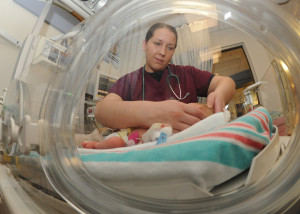April (April 22-29) has been designated as National Primary Immunodeficiency Awareness Month and provides an opportunity to better understand the more than 250 rare, genetic disorders in which the body’s normal immune system is absent or functions improperly. Since an important function of the immune system is to protect against infection, patients with primary immune deficiency have an increased susceptibility to infection.
Severe Combined Immune Deficiency (SCID), popularized in the 1976 movie “The Boy in the Plastic Bubble”, is generally considered to be the most serious of the primary immunodeficiencies. There are at least 13 different genetic defects that can cause the disease; all of which are present at birth, involve missing T lymphocytes which are important in identifying and attacking perceived “invaders”, and affect the function of B lymphocytes which produce antibodies against infection.
The absence of T lymphocytes and antibody immunity results in severe infections, diarrhea, and failure to thrive. Regardless of the genetics, patients invariably succumb to an early death due to overwhelming infection. New approaches to diagnosis and management have changed what at one time was a dismal prognosis.
Treatment options have come a long way over the past 4 decades and include enzyme replacement, bone marrow transplant, and gene therapy. Paramount to this change is early diagnosis before the infant has had a chance to develop any serious infections.
The most effective therapy to date is immune reconstitution via stem cell transplant which has been shown to be highly successful (94%) if performed by 3.5 months of age. Hence, timing is crucial in terms of diagnosis and treatment.
Typically, infants with SCID appear totally normal at birth and have no family history of immunodeficiency. In the past, patients were primarily identified either by previous family history, physical manifestations, or after onset of life-threatening infection. Early identification of SCID has been achieved through the use of the 7-cell receptor excision circle (TREC) assay as part of the routine newborn screening program.
Absent or low TREC levels can indicate insufficient T lymphocyte production characteristic of SCID, as well as low T lymphocyte, non-SCID conditions as seen in DiGeorge Syndrome, Trisomy 21, CHARGE Syndrome, and ataxia telangiectasia. On May 21, 2010, The U.S. Department of Health and Human Services (HHS) recommended that every state include the assay as part of the newborn screen.
In the landmark study based on retrospective data on more than 3 million infants from 11 newborn screening programs using the TREC methodology conducted by Jennifer Puck, MD and colleagues and published August 20, 2014 in The Journal of the American Medical Association, the value of early detection and treatment of SCID was confirmed.
In addition, the study found an incidence rate almost twice as great (1 in 58,000 births) as had been previously estimated. Since the point of newborn screening is to identify conditions for which early treatment is life-saving, the study was a crucial step in the adoption of universal screening.
As of April 1, 2016, all, except for 11, states have adopted routine newborn screening programs for SCID. A 2016 study published in the Journal of Pediatrics by Ding and others provided an eloquent cost-benefit analysis of newborn screening in the treatment of Severe Combined Immune Deficiency.
Based on data obtained from 86,000 infants in Washington state, the study showed that newborn screening for SCID is clearly cost-effective. Hopefully, the study provides additional support in economic terms for the adoption of universal screening programs in all 50 states.





